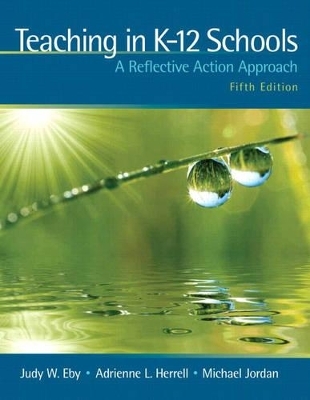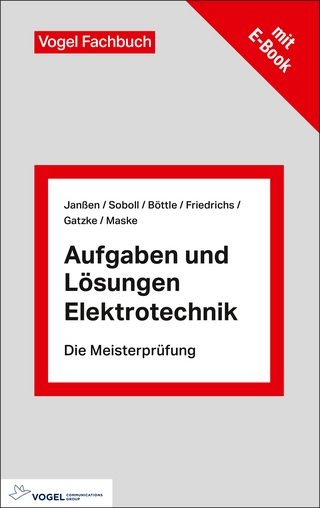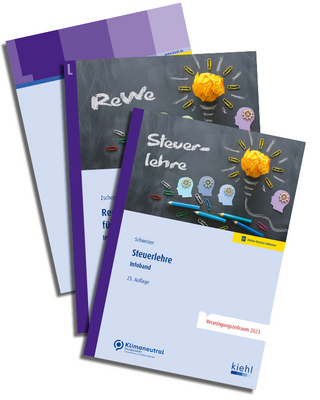
Teaching in K-12 Schools
Pearson
978-0-13-138133-9 (ISBN)
- Titel ist leider vergriffen;
keine Neuauflage - Artikel merken
Chapter 1: Reflective Action in Teaching Definitions of Reflective Thinking and Action
Reflective Action Builds on Withitness
Withitness
Reflective Action as it Relates to Withitness
National Standards
Reflecting on Your Ethics and Principles
A Graphic Model of reflective Action in Teaching
Communicating With Parents
Guided Group Exploration
REFLECTIVE ACTION EXPERIENCES FOR YOUR PORTFOLIO OF PROFESSIONAL PRACTICES
References
Chapter 2: Creating a Safe, Healthy, and Happy Classroom The First Week of School
Diana’s Reflective Process
Strategies Designed to Meet Student Needs
Planning for the First Day of School
Teacher’s Body Language
Establishing Rules and Consequences
Using Positive Consequences and Rewards
Reflective Action Case Study
Classroom Meetings
Issues in Classroom Management
Economic and Social Differences May Cause Varied Expectations of Students
Cheating by Students and Teachers
Establishing Two-Way Communication with Parents
Teaching Students How to Resolve Conflicts
Reflective Action Case Study
Scheduling Time for Active Learning
Daily and Weekly Schedules
Planning Time
Communicating with Parents
Guided Group Exploration
REFLECTIVE ACTION EXPERIENCES FOR YOUR PORTFOLIIO OF PROFESSIONAL PRACTICES
References
Chapter 3: Lesson Planning and Sequencing Clarifying Educational Goals and Outcomes
Writing Useful and Appropriate Outcome Statements
Writing Objectives o Fit Goals and Outcome Statements
Educational Objectives
Planning for Higher Level Thinking
Planning Lessons for Active learning
Predicting Possible Outcomes of Your Lesson Plans
Varying Objectives for Students with Special Needs
Writing a Well Organized Lesson Plan
A Lesson Plan Model
Sequencing Objectives in School Subjects
Sequencing Objectives in Mathematics
Sequencing Objectives in Language Arts
Sequencing Objectives in Science
Sequencing Objectives in Social Studies
Sample Lesson Plans
Sample First Grade Lesson Plan
Sample Science Lesson Plan
Long Term Curriculum Planning
An Example of a Middle School Plan for Mathematics
Collaborative Long-Term Planning
High School Teachers Collaborate in Long-Term Planning
Communicating With Parents
Playing Catch Up
Guided Group Exploration
REFLECTIVE ACTION EXPERIENCES FOR YOUR PORTFOLIO OF PROFESSIONAL PRACTICES
References
Chapter 4: Planning Curriculum Units Planning Curriculum Units
Diane Leonard’s First 3 Months at School
How School Curricula Are Planned
National Standards and Federal Mandates
State Standards are the Basis for Curriculum Planning
Other Influences that Affect Curriculum Planning
Evaluation and Use of Textbooks
Planning Thematic Units to Fit Your Curriculum
Deciding on a Unit Focus
Creating a Curriculum Unit Using reflective Action
Sequencing Learning Experiences
Designing the Curriculum to Reflect Multicultural Values
Planning Curriculum for a Multicultural Bilingual Classroom
Time Lines that Fit Your Goals and Outcome Statements
Examples of Thematic Units
A Multi-disciplinary Primary Unit
A Fourth Grade Social Studies/Literature Unit
A Middle School Mathematics Unit
A Science Unit at Yellowstone Park
Long Range Planning for Unit Study
Language Arts Planning for the Primary Grades
Communicating With Parents
Playing Catch Up
Guided Group Exploration
REFLECTIVE ACTION EXPERIENCES FOR YOUR PORTFOLIO OF PROFESSIONAL PRACTICES
References
Chapter 5: Assessing Students’ Diverse Needs Language Acquisition and the Classroom Teacher
Language Scaffolding
The Stages of Language Acquisition
Five Factors in Meeting the Needs of Diverse Students
The Forgotten Minority
Interactive Goal Setting
Building Self-Esteem and Intrinsic Motivation
The Enhancing Effects of Success
Reforming Schools to Provide Multicultural Values
Using Assessment Devices to Identify Student Needs
Interpreting Data from Students’ Cumulative Folders
Avoid Labeling Students
Authentic Assessment for a Diverse Student Body
Placement and Grouping Decisions
Performance Sampling
Communicating With Parents
Playing Catch Up
Guided Group Exploration
REFLECTIVE ACTION EXPERIENCES FOR YOUR PORTFOLIO OF PROFESSIONAL PRACTICES
References
Chapter 6: Establishing a Basis for Active, Authentic learning Retrieval Process
Schema Theory
Advance Organizers
Differentiated Instructional Strategies
Presentation Skills that Increase Clarity and Motivation
Getting Students’ Attention
Enthusiasm
Clarity
Smooth Transitions
Timing
Variation
Interaction
Systematic Classroom Instruction
Direct Instruction of New Knowledge and Skills
Teacher Modeling and Demonstrations
Structuring Tasks for Success
Matching Learning Styles and Teaching Styles
Learning Experiences Designed for Multiple Intelligences
Communicating With Parents
Guided Group Exploration
REFLECTIVE ACTION EXPERIENCES FOR YOUR PORTFOLIO OF PROFESSIONAL PRACTICES
References
Chapter 7: Teaching Strategies That Increase Authentic learning Examples of Teaching Strategies in Action
Discovery Learning
Inquiry Training
Role Playing
Storytelling
Simulation
Mastery Learning
Contracts for Independent learning
Group Rotations Using Learning Centers
Reflective Action Case Study – Establishing Learning Centers
Cooperative learning Strategies
Learning Teams Enhance Achievement
Cooperative learning of the Basic Skills
Cooperative learning in Science
Literature Circles
Peacemaking Groups
Creating Well-Balanced Cooperative Groups
The Effects of Cooperative Learning
Communicating With Parents
Guided Group Exploration
REFLECTIVE ACTION EXPERIENCES FOR YOUR PORTFOLIO OF PROFESSIONAL PRACTICES
References
Chapter 8: Engaging Students in Classroom Discussions Asking Questions that Stimulate Higher Level Thinking
Strategies for Interactive Discussions
Group Investigations
Discussions that Promote Critical Thinking
Discussions that Improve Observations Skills
Discussions that Enhance Comparison Skills
Discussions that Guide Classification Skills
Discussions that Identify Assumptions
Socratic Dialogues
Discussions that Enhance Creative Thinking
Discussions that Encourage Imagination and Inventiveness
Prewriting Discussions
Discussions that Address Multiple Intelligences
Role of the teacher in Leading Discussions
Communicating With Parents
Guided Group Exploration
REFLECTIVE ACTION EXPERIENCES FOR YOUR PORTFOLIO OF PROFESSIONAL PRACTICES
References
Chapter 9: Balancing Standards and Creative Activities The Importance of the Arts
Encourage Creativity – Provide Materials
Materials from Homes
Materials from Merchants
Other Sources of Materials
Setting a Creative Tone
Creative Atmosphere
How to Encourage Creativity in Students
The Self-Fulfilling Prophesy
Stereotypes Stifle Creativity
Ways to Demonstrate Valuing Creativity
Core Attitudes in Creative Thought
Creativity in the Language Arts
Email stories
Creative Activities in Mathematics
Creative Activities in Social Sciences
Creative Activities in Science
Creative Activities in the Visual and Performing Arts
Humor and Creativity
Styles of Humor-oriented Teaching
Creativity Training
Communicating With Parents
Playing Catch Up
Guided Group Exploration
REFLECTIVE ACTION EXPERIENCES FOR YOUR PORTFOLIO OF PROFESSIONAL PRACTICES
References
Chapter 10: Assessing and Reporting Student Accomplishments How teachers Select and Use Assessment Procedures
Informal Observations
Performance Tasks to Show Mastery of Objectives
Rubric for Communication Skills and Oral Presentations
Criterion-Referenced Quizzes and Tests
Mastery Learning Assessment
Essays Evaluated with Rubric Guidelines
Oral Reports and Examinations
Designing Authentic Assessment Tasks
Rubrics, Checklists, and Rating Scales
Learning Contracts
Portfolios of Student Products
Reflective Action Case Study – A Teacher’s Reflection on Portfolio Assessment
Videotape Records
Grading Cooperative Group Projects and Products
Reporting Student Accomplishments
Electronic Management Systems
Computation of Grades
Writing Anecdotal Records
Involving Students in Evaluation Procedures
Communicating With Parents
Playing Catch Up
Guided Group Exploration
REFLECTIVE ACTION EXPERIENCES FOR YOUR PORTFOLIO OF PROFESSIONAL PRACTICES
References
Chapter 11: Integrating Technology into the Curriculum Preparing Students to Thrive in a High -Tech World
Using technology to Track How Teachers Meet State Standards
Reasons to Incorporate Technology into Your Curriculum
Managing Your Classroom With (and For) Technology
Enhancing Your Instructional Strategies with Productivity Software
Word Processing Programs
Presentation Software
Data Manipulation
Spreadsheets
Databases
Educational Software
Extending Classroom Experiences Beyond the Classroom Walls
Computer-Assisted Research Projects
Computer Literacy Program at Beardsley School
Tracking the Return of Spring on the Internet
The Advantages of Teacher to Teacher Networking
Communicating With Parents
Playing Catch Up
Guided Group Exploration
REFLECTIVE ACTION EXPERIENCES FOR YOUR PORTFOLIO OF PROFESSIONAL PRACTICES
References
Chapter 12: Reflecting on Teaching and the School Community The Teacher’s Role in he Community
No Child Left Behind
Two-Way Communication with Parents
Fall Open House
Parent-Teacher Conferences
Talking to Parents about Underachievement
Through the Eyes of Parents
Teaching and Learning in a Multicultural Community
Visits to Students’ Homes
Newsletters and Notes
Telephone Calls
Spring Open House and Other Special Events
Community Involvement in Classroom Activities
Parents as Volunteers
Community Resources
Character and Moral Education Programs
Teachers Mentoring and Coaching One Another
Interacting with Colleagues in Creating Professional Portfolios
The Powerful Influence a Teacher Can Make
Playing Catch Up
Guided Group Exploration
REFLECTIVE ACTION EXPERIENCES FOR YOUR PORTFOLIO OF PROFESSIONAL PRACTICES
References
| Erscheint lt. Verlag | 22.11.2010 |
|---|---|
| Sprache | englisch |
| Gewicht | 771 g |
| Themenwelt | Sozialwissenschaften ► Pädagogik ► Berufspädagogik |
| ISBN-10 | 0-13-138133-4 / 0131381334 |
| ISBN-13 | 978-0-13-138133-9 / 9780131381339 |
| Zustand | Neuware |
| Haben Sie eine Frage zum Produkt? |
aus dem Bereich


